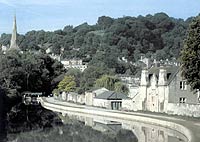THE
CANAL - THE KENNET & AVON CANAL Construction
of the Kennet & Avon Canal began in the mid 1790s. It is an impressive feat of
engineering, with many examples of canal industrial heritage.  | | Running
from the River Avon Navigation at Bristol to the River Thames at Reading, it provides
the link to complete a continuous waterway across Southern England from Bristol
to London. From Hanham Lock, Bristol to Blake's Lock, Reading is a distance of
87 miles, with 105 locks and it is under the jurisdiction of British Waterways. | Bath
Flight |
Hanham
Lock is the junction of the Avon with the canal. It is on the outskirts of Bristol,
30 feet above sea level and the waters are tidal. From here, the river and canal
run as one, through nine locks, into the city of Bath.
At Bath, the river and the canal separate and the canal climbs 70 feet through
the Widcombe Flight of six locks. One of these locks, Bath Deep Lock, is the second
deepest in Britain. After
Bath Top Lock, the canal passes under Cleveland House, the original headquarters
of the Kennet & Avon Canal Company and then follows the contours of the southern
side of the Avon Valley. Along the valley, the Claverton Pumping Station, situated
between the two waterways, is a water-driven pump lifting water from the River
Avon to replenish the levels in the canal. | Dundas
Aqueduct, built by John Rennie, the canal's principal engineer, carries the canal
to the northern side of the Avon Valley. This aqueduct, considered to be John
Rennie's best architectural work, is followed 2 ½ miles later by a second aqueduct,
which returns the canal to the southern side of the valley. | | | | | | John
Rennies |
| | The
canal skirts the small market town of Bradford-on-Avon and, passing to the north
of Trowbridge, the canal leaves the confines of the Avon valley and heads out
across the Wiltshire countryside. It passes through the villages of Semington
and Seend before approaching Devizes and the Caen Hill Flight of 16 locks, one
the most spectacular features of Britain's inland waterways. The Caen Hill Flight
lifts the canal 237 feet over a distance of 2 ¼ miles into the town of Devizes. | Caen
Hill flight | | | |
| From
Devizes, there is 15 miles of lock free canal along the Vale of Pewsey known as
the Long Pound. After passing to the north of Pewsey, the canal climbs to its
summit level through the Wootton Rivers Flight to reach 450 feet above sea level.
The canal edges the vast Savernake Forest before entering Bruce Tunnel, a tunnel
designed to take two way traffic and a third of a mile long. | | | | | | The
Long Pound |
| | Once
through Bruce Tunnel, the canal descends the Summit Pound by the Crofton Flight.
At the bottom of the flight, Crofton Pumping Station, another John Rennie design,
is an important part of the canal's rich industrial heritage. It houses one of
the oldest working beam engines in the world and raises water from the reservoir
at Wilton Water, to the summit level of the canal. | Crofton
in Steam | | |
As
the canal passes through Great and Little Bedwyn, Hungerford and Kintbury, it
closely follows the main railway line from Bristol to London, formerly the Great
Western Railway. At Hungerford, the canal enters the Kennet Valley and runs steadily
downhill to Newbury. | As
the canal approaches Newbury, it makes use of canalised sections of the River
Kennet and then passes through Newbury town centre. Built in 1796, Newbury Lock
was the first lock to be built on the Kennet & Avon Canal. | | | | | | River
Kennett |
| | Garston
Lock is in the outer suburbs of Reading, close to where the M4 motorway spans
the canal. This is Britain's last working turf-sided lock, one of many listed
structures along the waterway, and restored by British Waterways in conjunction
with English Heritage and the District Council. | Avon
Cliffe Aqueduct | | |
The
canal runs through the centre of Reading, passed the modern Oracle Shopping Centre
and on to Blake's Lock, where the canal finally joins the River Thames. During
the second half of the 19th century, after the opening of the Great Western Railway,
the Kennet & Avon Canal fell into a state of partial dereliction. However, since
1962 The Kennet and Avon Canal Trust has worked to restore the Kennet & Avon Canal
to its former glory and together with British Waterways, local authorities and
members of the Association of Canal Enterprises, it has formed the Kennet and
Avon Partnership. By
1990, after years of raising money and, with a tremendous amount of voluntary
help, the Partnership was able to make the canal navigable once again. In August
1990, Her Majesty the Queen re-opened the Kennet & Avon Canal to through navigation.
In 1994,
there were celebrations to mark the 200th anniversary of the canal and by the
end of 1996; the Partnership had been awarded a record amount of £25 million by
the Heritage Lottery Fund. They then raised an additional £4.2 million and work
began to repair locks and to dredge and reline the canal. Environmental improvements
were also made, along with improvements to disabled access. The
restoration work is now complete and, to mark 40 years of successful work, a summer
of celebrations has been planned. |

